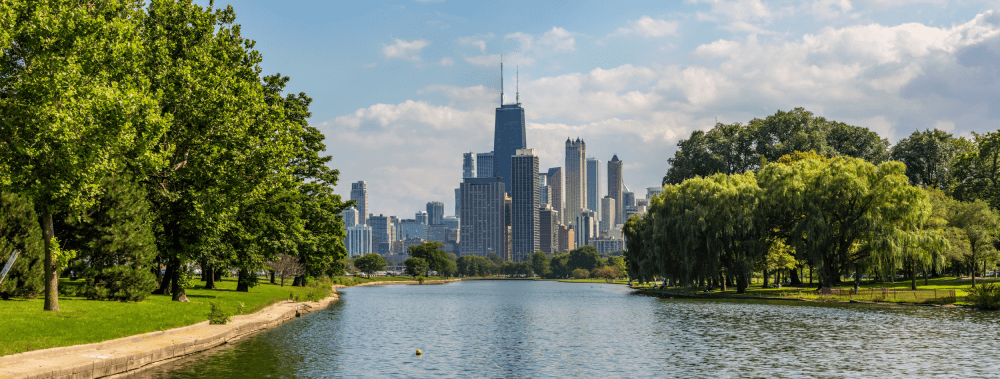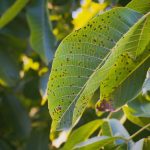We are back with our series on the common tree diseases and insect pests in Illinois with a closer look at a dangerous fungal disease, verticillium wilt. Verticillium wilt is known to affect more than 350 species of flowering plants including shrubs, trees, fruits, and vegetables. This disease affects the xylem, or tissue responsible for the movement of water within the tree, which makes it difficult for water to get to the branches. As a result, branches, leaves, and flowers, fruit, and vegetables will begin to wilt and die. In many cases, verticillium wilt is fatal to the affected plant.
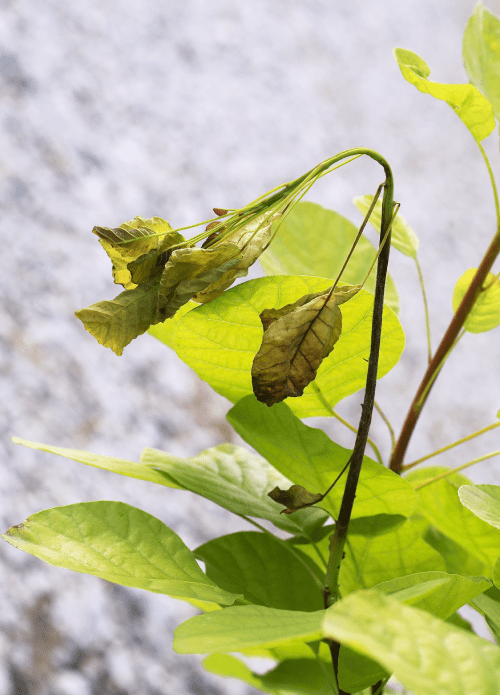
Verticillium Wilt can be extremely fatal to Chicagoland trees and should be dealt with immediately by a professional arborist
Most cases of verticillium wilt are caused by the fungus Verticillium dahliae that is found in soil. This fungus forms structures called microsclerotia in the soil and they affect the roots of trees and plants that grow too close to them. The fungus then enters the root system and spreads through the plant’s vascular system, causing damage to the xylem and disrupting the flow of water. There are a large number of trees and plants native to Illinois that can become affected by verticillium wilt including maple trees, redbuds, magnolia trees, cherry trees, plum trees, sassafras, elm trees, and a wide variety of fruits and vegetables including cabbage, berries, and more.
In this guide, we will take a closer look at verticillium wilt, including how it infects plants, the common signs of the disease, and what you can do to prevent and control this disease. At Hendricksen Tree Care, our professional arborists can diagnose trees and shrubs affected by verticillium wilt and treat them with our tree care and maintenance services. We will assess the condition of your trees and the progression of the verticillium wilt and form an effective plan to treat your trees. Verticillium wilt can result in significant damage and even the death of your tree so you need to contact our professionals at Hendricksen Tree Care as soon as you notice any signs of this disease.
Life Cycle of Verticillium Wilt
In most cases of verticillium wilt, Verticillium dahliae is the culprit, but this disease can also be caused by Verticillium albo-atrum, Verticillium nigrescens, Verticillium nubilum, and Verticillium tricorpus. Verticillium dahliae lives as darkened structures called microsclerotia in the soil which can be dormant for years. When roots grow close to the microsclerotia, the fungi become germinated by the root exudates and will grow beyond the structure and towards the root. The fungus often enters the roots through wounds created by soil abrasion to access the vascular system.
The fungus will find the xylem of the plant once it enters and create spores known as conidia. Conidia can quickly and easily spread throughout the plant through the xylem and colonize. The water flow within the xylem allows the conidia to move throughout the plant and the structures they form will clog the vascular system and restrict water flow. When this happens, the water cannot get to the branches, causing the branches, leaves, and flowers, vegetables, or fruit to wilt. Plants that are heavily infected are likely to die quickly while lesser infections can kill a plant slowly over a couple of years.
As the host plant dies, the conidia start forming survival structures that produce microsclerotia. These survival structures will remain where the plant dies off and they will release the microsclerotia into the soil where it will lay dormant until it is germinated by another plant, starting the cycle over again.
Season for Verticillium Wilt
Verticillium fungi are very hardy as they can survive harsh weather conditions from heat and droughts to freezing temperatures and thaws. The only conditions they do not tolerate are flooding and other conditions that deprive them of oxygen.
Verticillium fungi grows best in temperatures between 70 and 80 degrees Fahrenheit, but they can germinate in lower and higher temperatures. In Illinois, the main symptoms of verticillium wilt appear in July, but they may show at any time between May and October.
Verticillium Wilt Transmission
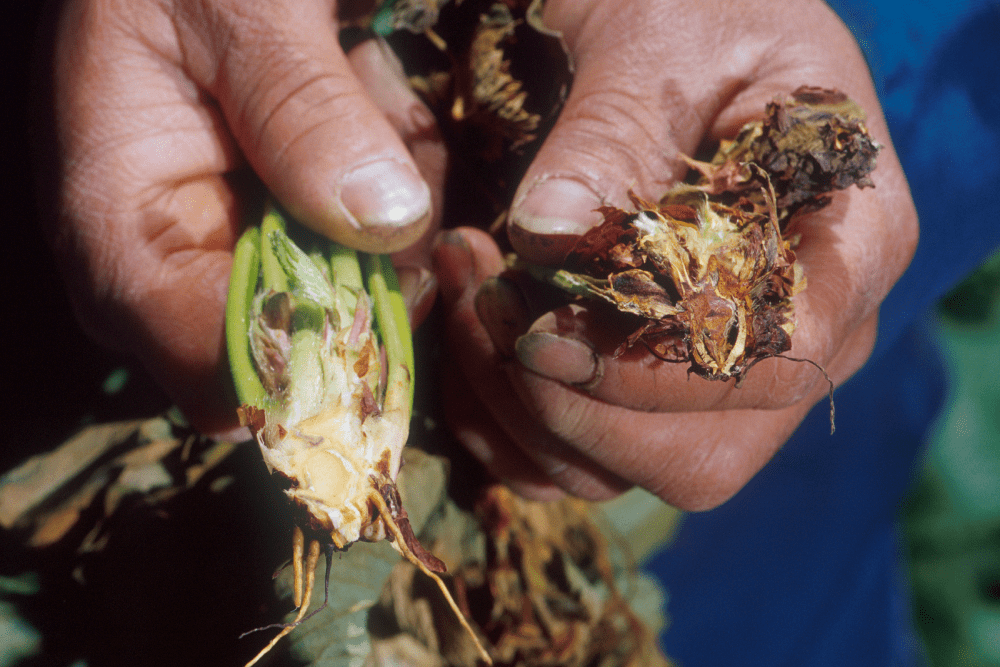
A healthy strawberry plant root compared to a strawberry plant root infected with Verticillium Wilt. Photo courtesy of Wikipedia.org / ARS Photo Library / Brian Prechtel (original source: http://www.ars.usda.gov/is/graphics/photos/jan01/k9194-1.htm)
The most common way for plants to become infected by verticillium wilt is through the roots as explained above. However, there are several other ways verticillium wilt can spread including root to root contact between plants. Conidia can also spread though the air and infect healthy plants above ground. Planting affected seeds without treating them with fungicides can spread verticillium wilt as well.
Insects are also responsible for the transmission of verticillium wilt as leaf cutter bees, aphids, and potato leafhoppers are a few of the insects known to transmit conidia. These insects often create wounds in the leaves of branches which gives the fungus a way into the plant.
Which Plants are Vulnerable to Verticillium Wilt?
There are more than 350 species of eudicot plants that are vulnerable to verticillium wilt. Vulnerable species include trees and shrubs, vines, fruits, vegetables, and others. The following are just some of the plants susceptible to verticillium wilt:
Trees Susceptible to Verticillium Wilt:
- Maple, Ohio buckeye, redbud, dogwood, ash, red oak, sassafras, American elm
Flowers Susceptible to Verticillium Wilt:
- Snapdragon, bellflower, safflower, chrysanthemum, sunflower, strawflower, garden balsam, magnolia
Fruits / Vegetables Susceptible to Verticillium Wilt:
- Cauliflower, cabbage, brussel sprouts, watermelon, honeydew, cantaloupe, cucumber, pumpkin, strawberry, tomato, olive, avocado, cherry, plum, peach, gooseberry, eggplant, spinach
Signs of Verticillium Wilt
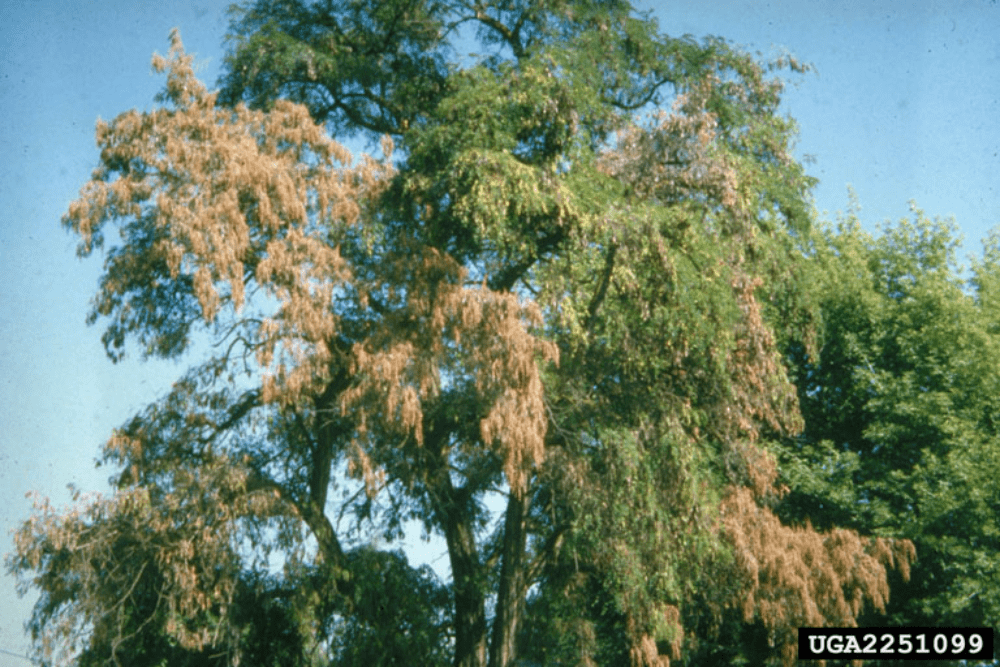
An adult tree with wilting leaves infected with Verticillium Wilt. Photo courtesy of Wikipedia.org / USDA Forest Service
Trees and other plants affected by verticillium wilt cannot get water to their branches which will cause wilting and dieback of the branches, leaves, flowers, and fruit. The visible symptoms of verticillium wilt are similar to those of other diseases and environmental issues which makes it difficult to diagnose. It is important to know all of the symptoms of verticillium wilt so you can take action and have your infected trees and plants treated right away.
The following are the main verticillium wilt symptoms:
- Wilting leaves: Wilting leaves is one of the most obvious symptoms as the water deprived leaves will turn yellow or brown around the edges before becoming wilted. The affected leaves will eventually fall off.
- Wilting flowers, fruits, and vegetables: The limited water flow caused by verticillium wilt will cause the flowers, fruits, or vegetables of the plant to become discolored and wither away.
- Branch dieback: The lack of water can cause entire branches to die and inhibit the growth of new twigs.
- Cankers: Cankers are areas of dead bark that can appear on the branches of infected maples and other types of trees.
- Discolored sapwood: The discoloration of the internal sapwood is the symptom that confirms the problem is verticillium wilt. If you peel off the bark or look at a cross section of the tree, you can see dark colored brown or green streaks in the sapwood. The color of the streaks may differ depending on the type of plant infected.
Verticillium Wilt Treatment and Management
While the symptoms mentioned above likely indicate an infection of verticillium wilt, only a lab test can tell for sure. If you notice these symptoms on your trees or plants, you need to call a professional arborist immediately to diagnose and treat your plants. Trees and other plants infected with verticillium wilt cannot be cured, but steps can be taken to contain the effects.
The following actions can help you control verticillium wilt:
- Prune affected branches: The most effective way to treat trees and plants already affected by verticillium wilt is by pruning the affected branches. Pruning dead and damaged branches will help restore the vigor of the plant and prevent the fungus from spreading. If you prune the branches yourself, make sure you disinfect the tools you use because the disease can be transmitted with contaminated tools. You can also have a professional provide tree trimming to remove the affected branches.
- Remove small plants and heavily affected trees: If you have a plant affected by verticillium wilt in a vegetable garden or flower garden, remove the plant. Smaller plants cannot be saved once infected and removing the infected plants will help prevent the disease from spreading. Trees that are heavily affected also need to be removed or they will continue to fall apart and spread the disease. Because the fungus that causes verticillium wilt lives in the soil, you should replace removed plants and trees with plants that are resistant to verticillium wilt.
- Water and fertilize plants: Make sure any plants or trees on your property that are susceptible to verticillium wilt are properly watered and fertilized to give them a better chance of resisting the disease. Plants and trees should be watered regularly and fertilized with low-nitrogen, high-phosphorous fertilizer.
- Soil fumigation: Soil fumigation is a process in which the top 6 inches of soil is heated up to a temperature that kills off the fungus. This process tends to work better in warm weather climates and my not be the best option in Illinois. The soil fumigation option should be discussed with a professional arborist.
- Plant verticillium resistant trees and plants: If you are planting new trees and plants in your yard, plant trees that are naturally resistant to verticillium wilt. Trees that are resistant to verticillium wilt include alder, hickory, Cornus species dogwoods, beech, juniper, mulberry, sycamores, white oaks, willows, and more.
Tree Care and Maintenance from Henricksen Tree Care
Verticillium wilt is a fatal disease that causes wilting of leaves, branches, flowers, fruits, and vegetables due to a disruption of the movement of water. There is no way to cure trees and plants affected by verticillium wilt and the disease can kill infected plants over a couple of years or within weeks. If you notice any signs of verticillium wilt among your trees or plants, you need to call a professional arborist immediately.
The arborists of Hendricksen Tree Care can accurately diagnose trees and shrubs affected by diseases and take actions to resolve the issue. We provide professional tree pruning to remove damaged and diseased branches and we can ensure that your trees are properly fertilized to increase their resistance against diseases like verticillium wilt. Hendricksen Tree Care is ready to provide tree care and maintenance services in Arlington Heights, Highland Park, Barrington, Northbrook, Lake Forest, Park Ridge, Glenview, and the surrounding north and northwest Chicago suburbs.
Watch for the next installment of our series common tree diseases and insect pests in the Chicago area.
